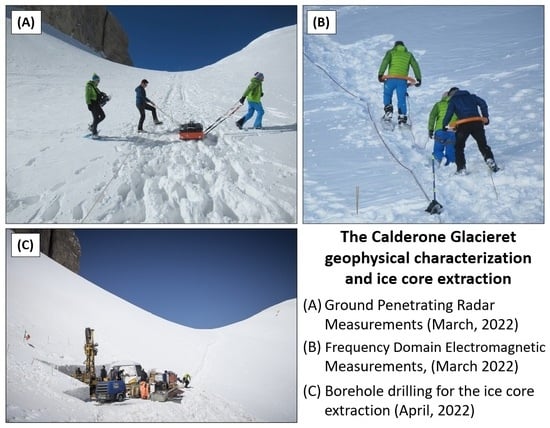Combining Ground Penetrating Radar and Frequency Domain Electromagnetic Surveys to Characterize the Structure of the Calderone Glacieret (Gran Sasso d’Italia, Italy)
Abstract
:1. Introduction
2. Site Description
3. Methods
3.1. Ground Penetrating Radar (GPR)
3.2. Frequency Domain Electromagnetic (FDEM)
3.3. FDEM Forward and Inverse Modelling
4. Results
4.1. GPR Results
4.2. FDEM Inversion Results
4.3. FDEM Forward Modelling Results
4.4. FDEM Correction Factor
5. Discussion
6. Conclusions
Author Contributions
Funding
Data Availability Statement
Acknowledgments
Conflicts of Interest
Appendix A
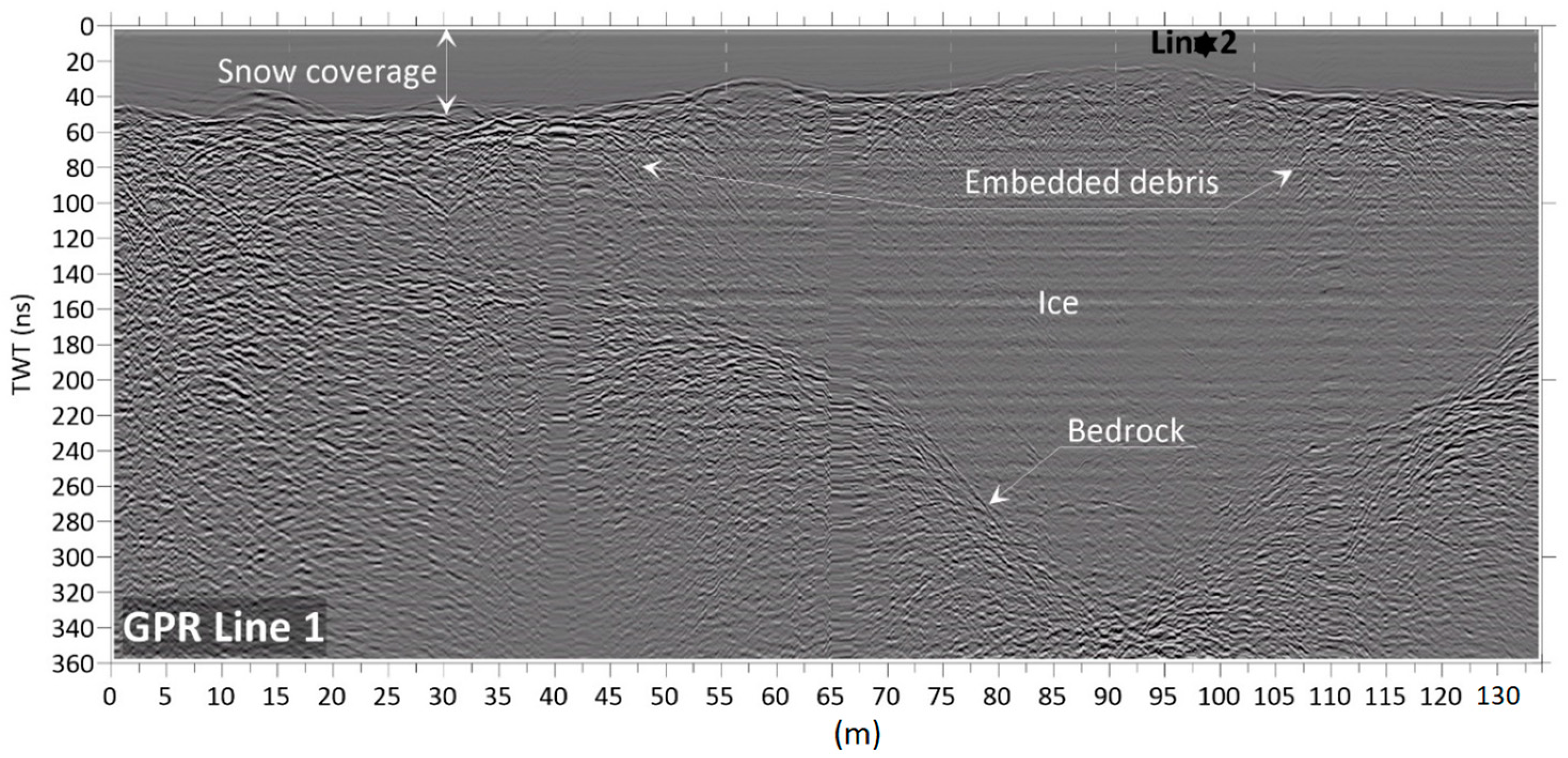

References
- Pecci, M.; Smiraglia, C.; D’Orefice, M. Il Ghiacciaio Del Calderone. Riv. Aineva Neve E Valanghe 1997, 57, 32. [Google Scholar]
- Crepaz, A.; Cagnati, A.; De Luca, G. Evoluzione Dei Ghiacciai Delle Dolomiti Negli Ultimi Cento Anni. Neve E Valanghe 2013, 80, 20–25. [Google Scholar]
- Marinelli, O.; Ricci, L. Alcune Osservazioni Sul Ghiacciaio Del Gran Sasso. Riv. Geogr. It 1916, 23, 399–405. [Google Scholar]
- Pecci, M.; D’Agata, C.; Smiraglia, C. Ghiacciaio Del Calderone (Apennines, Italy): The Mass Balance of a Shrinking Mediterranean Glacier. Geogr. Fis. E Din. Quat. 2008, 31, 55–62. [Google Scholar]
- Tonini, D. Il Ghiacciaio Del Calderone Del Gran Sasso d’Italia. Boll. Del Com. Glaciol. Ital. 1961, 10, 71–134. [Google Scholar]
- Smiraglia, C.; Veggetti, O. Recenti Osservazioni Sul Ghiacciaio Del Calderone (Gran Sasso d’italia, Abruzzo). Boll. Della Soc. Geogr. Ital. 1992, 9, 269–302. [Google Scholar]
- Gellatly, A.F.; Smiraglia, C.; Grove, J.M.; Latham, R. Recent Variations of Ghiacciaio Del Calderone, Abruzzi, Italy. J. Glaciol. 1994, 40, 486–490. [Google Scholar] [CrossRef]
- Lüthi, M.P.; Funk, M.; Bauder, A. Comment on ‘Integrated Monitoring of Mountain Glaciers as Key Indicators of Global Climate Change: The European Alps’ by Haeberli and Others. J. Glaciol. 2008, 54, 199–200. [Google Scholar] [CrossRef]
- Stenni, B. Applicazione Degli Isotopi Stabili in Paleoclimatologia: Le Carote Di Ghiaccio. Studi Trent. Sci. Nat. Acta Geol. 2005, 80, 17–27. [Google Scholar]
- Arcone, S.A.; Lawson, D.E.; Delaney, A.J. Short-Pulse Radar Wavelet Recovery and Resolution of Dielectric Contrasts within Englacial and Basal Ice of Matanuska Glacier, Alaska, U.S.A. J. Glaciol. 1995, 41, 68–86. [Google Scholar] [CrossRef]
- Maurer, H.; Hauck, C. Geophysical Imaging of Alpine Rock Glaciers. J. Glaciol. 2007, 53, 110–120. [Google Scholar] [CrossRef]
- Forte, E.; Pipan, M.; Francese, R.; Godio, A. An Overview of GPR Investigation in the Italian Alps. First Break 2015, 33, 61–67. [Google Scholar] [CrossRef]
- Church, G.; Bauder, A.; Grab, M.; Maurer, H. Ground-Penetrating Radar Imaging Reveals Glacier’s Drainage Network in 3D. Cryosphere 2021, 15, 3975–3988. [Google Scholar] [CrossRef]
- Boaga, J. The Use of FDEM in Hydrogeophysics: A Review. J. Appl. Geophy. 2017, 139, 36–46. [Google Scholar] [CrossRef]
- Pecci, M.; Mugnozza, G. Il Gran Sasso in Movimento: Risultati Del Monitoraggio e Degli Studi Preliminari Sulla Frana Del 22 Agosto 2006; BONOMIA University Press: Bologna, Italy, 2007. [Google Scholar]
- Giraudi, C. Le Oscillazioni Del Ghiacciaio Del Calderone (Gran Sasso d’Italia, Abruzzo-Italia Centrale) e Le Variazioni Climatiche Degli Ultimi 3000 Anni. Lpine Mediterr. Quat. 2002, 15, 149–154. [Google Scholar]
- Pecci, M.; De Sisti, G.; Marino, A.; Smiraglia, C. New Radar Surveys in Monitoring the Evolution of the Calderone Glacier (Central Apennines, Italy). Suppl. Geogr. Fis. Dinam. Quat. 2001, 150, 145. [Google Scholar]
- Monaco, A.; Scozzafava, M. A Preliminary Survey for Testing Operativity and Efficiency of Gpr Technology by Means of Unshielded Antenna for The Study of Calderone Glacier, Central Italy. Alp. Mediterr. Quat. 2017, 30, 5–10. [Google Scholar]
- Urbini, S.; Baskaradas, J.A. GPR as an Effective Tool for Safety and Glacier Characterization: Experiences and Future Development. In Proceedings of the XIII Internarional Conference on Ground Penetrating Radar, Lecce, Italy, 21–25 June 2010; IEEE: Piscataway, NJ, USA, 2010; pp. 1–6. [Google Scholar]
- Urbini, S.; Bianchi-Fasani, G.; Mazzanti, P.; Rocca, A.; Vittuari, L.; Zanutta, A.; Girelli, V.A.; Serafini, M.; Zirizzotti, A.; Frezzotti, M. Multi-Temporal Investigation of the Boulder Clay Glacier and Northern Foothills (Victoria Land, Antarctica) by Integrated Surveying Techniques. Remote Sens. 2019, 11, 1501. [Google Scholar] [CrossRef]
- McLachlan, P.; Blanchy, G.; Binley, A. EMagPy: Open-Source Standalone Software for Processing, Forward Modeling and Inversion of Electromagnetic Induction Data. Comput. Geosci. 2021, 146, 104561. [Google Scholar] [CrossRef]
- Hauck, C.; Kneisell, C. Applied Geophysics in Periglacial Environments; Cambridge University Press: Cambridge, UK, 2008. [Google Scholar]
- Boaga, J.; Phillips, M.; Noetzli, J.; Haberkorn, A.; Kenner, R.; Bast, A. A Comparison of Frequency Domain Electro-Magnetometry, Electrical Resistivity Tomography and Borehole Temperatures to Assess the Presence of Ice in a Rock Glacier. Front. Earth Sci. 2020, 8, 593. [Google Scholar] [CrossRef]
- Pavoni, M.; Sirch, F.; Boaga, J. Electrical and Electromagnetic Geophysical Prospecting for the Monitoring of Rock Glaciers in the Dolomites, Northeast Italy. Sensors 2021, 21, 1294. [Google Scholar] [CrossRef] [PubMed]
- Goovaerts, P. Geostatistics for Natural Resources Evaluation; Oxford University Press: Oxford, UK, 1997. [Google Scholar]
- Hansen, P.C. The L-Curve and Its Use in the Numerical Treatment of Inverse Problems; WIT Press: Billerica, MA, USA, 1999. [Google Scholar]
- McNeill, J. Electromagnetic Terrain Conductivity Measurement at Low Induction Numbers; Geonics Ltd.: Mississauga, ON, Canada, 1980. [Google Scholar]
- Gélis, C.; Revil, A.; Cushing, M.E.; Jougnot, D.; Lemeille, F.; Cabrera, J.; De Hoyos, A.; Rocher, M. Potential of Electrical Resistivity Tomography to Detect Fault Zones in Limestone and Argillaceous Formations in the Experimental Platform of Tournemire, France. Pure Appl. Geophys. 2010, 167, 1405–1418. [Google Scholar] [CrossRef]
- Santin, I.; Roncoroni, G.; Forte, E.; Pipan, M. GPR Inversion and Modelling for Glacial Internal Debris Estimation and Characterization. In Proceedings of the 19th International Conference on Ground Penetrating Radar, Golden, CO, Canada, 12–17 June 2022; Society of Exploration Geophysicists: Houston, TX, USA; pp. 39–42. [Google Scholar]
- Pavoni, M.; Carrera, A.; Boaga, J. Improving the Galvanic Contact Resistance for Geoelectrical Measurements in Debris Areas: A Case Study. Near Surf. Geophys. 2022, 20, 178–191. [Google Scholar] [CrossRef]



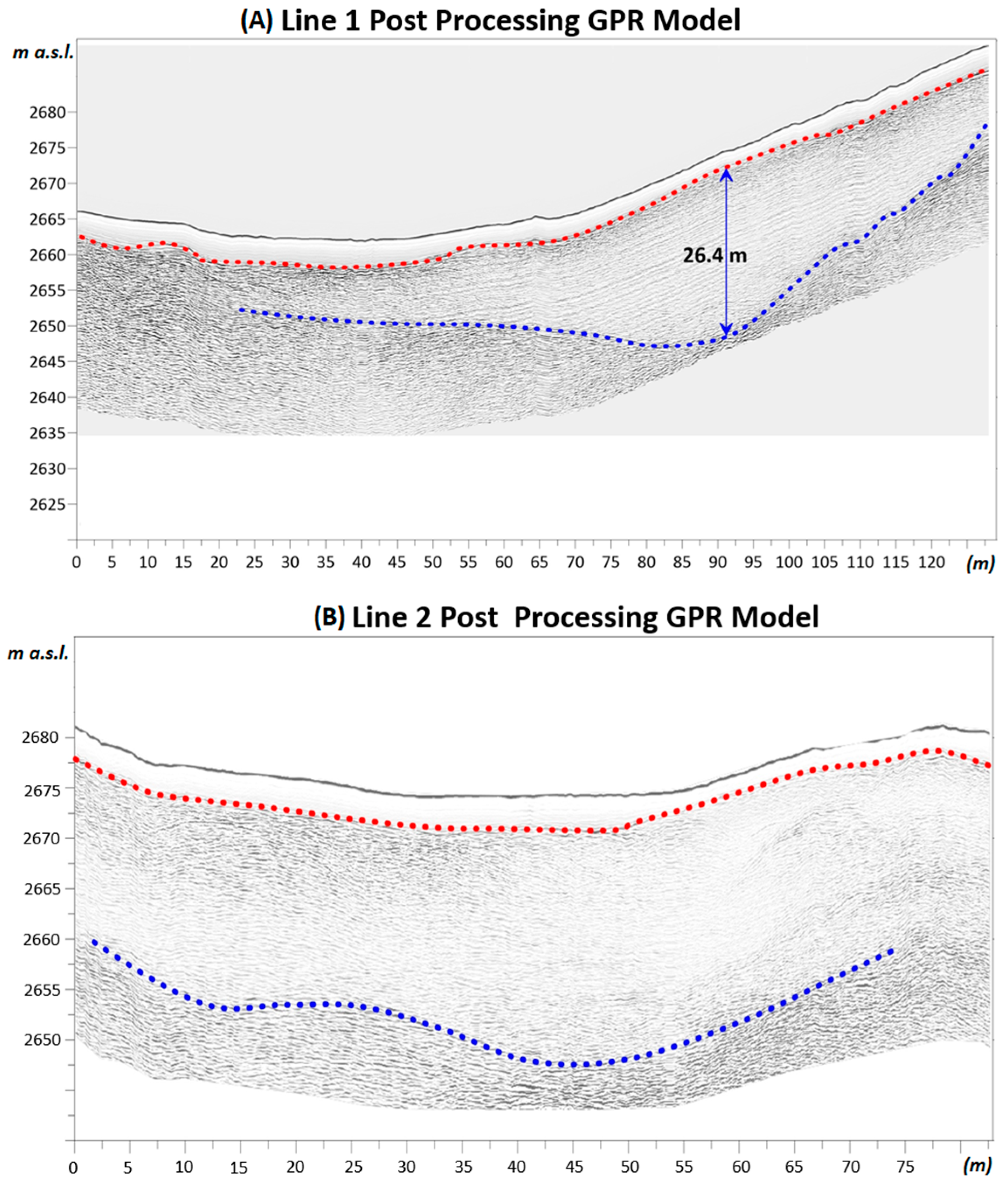
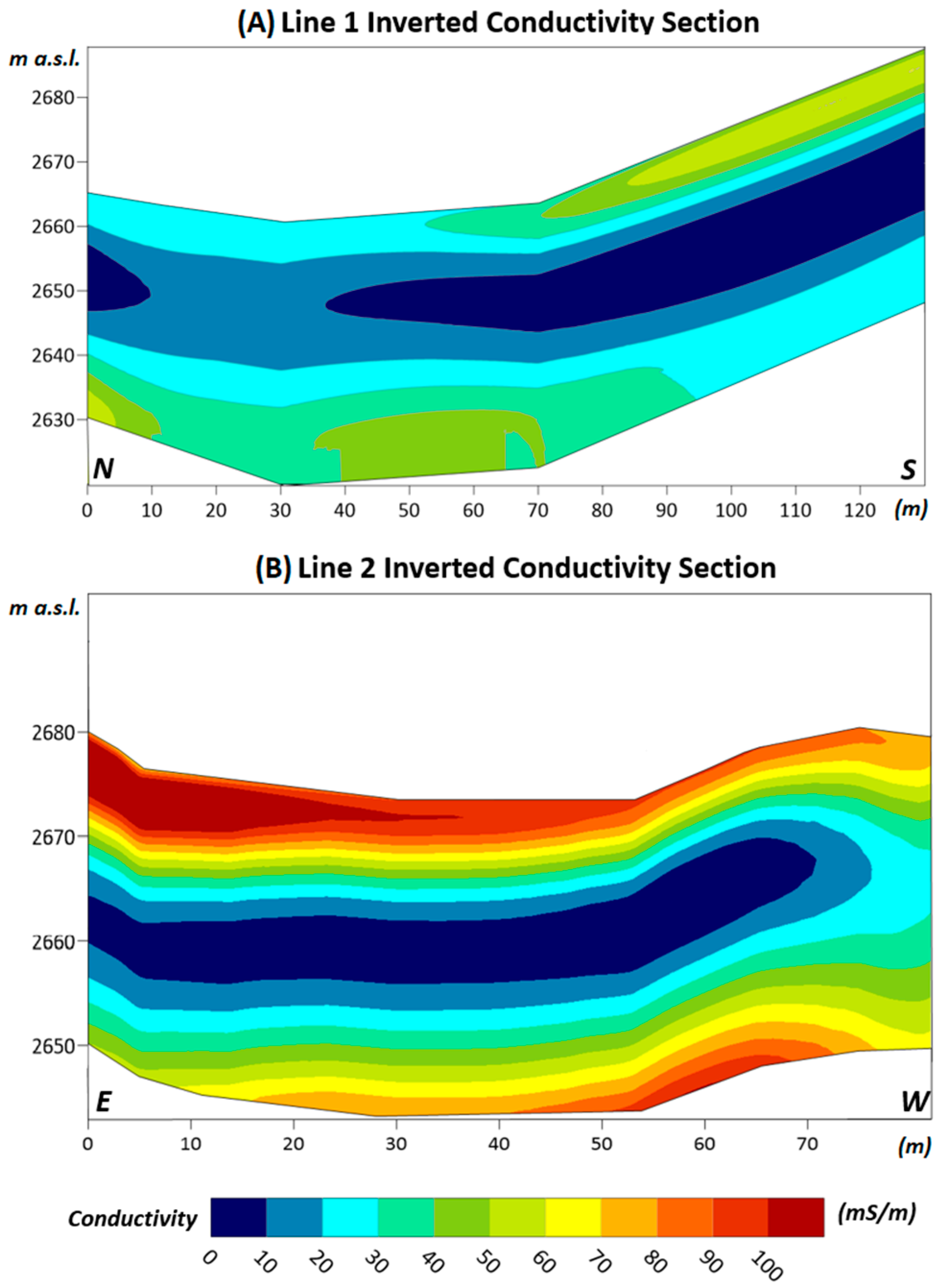

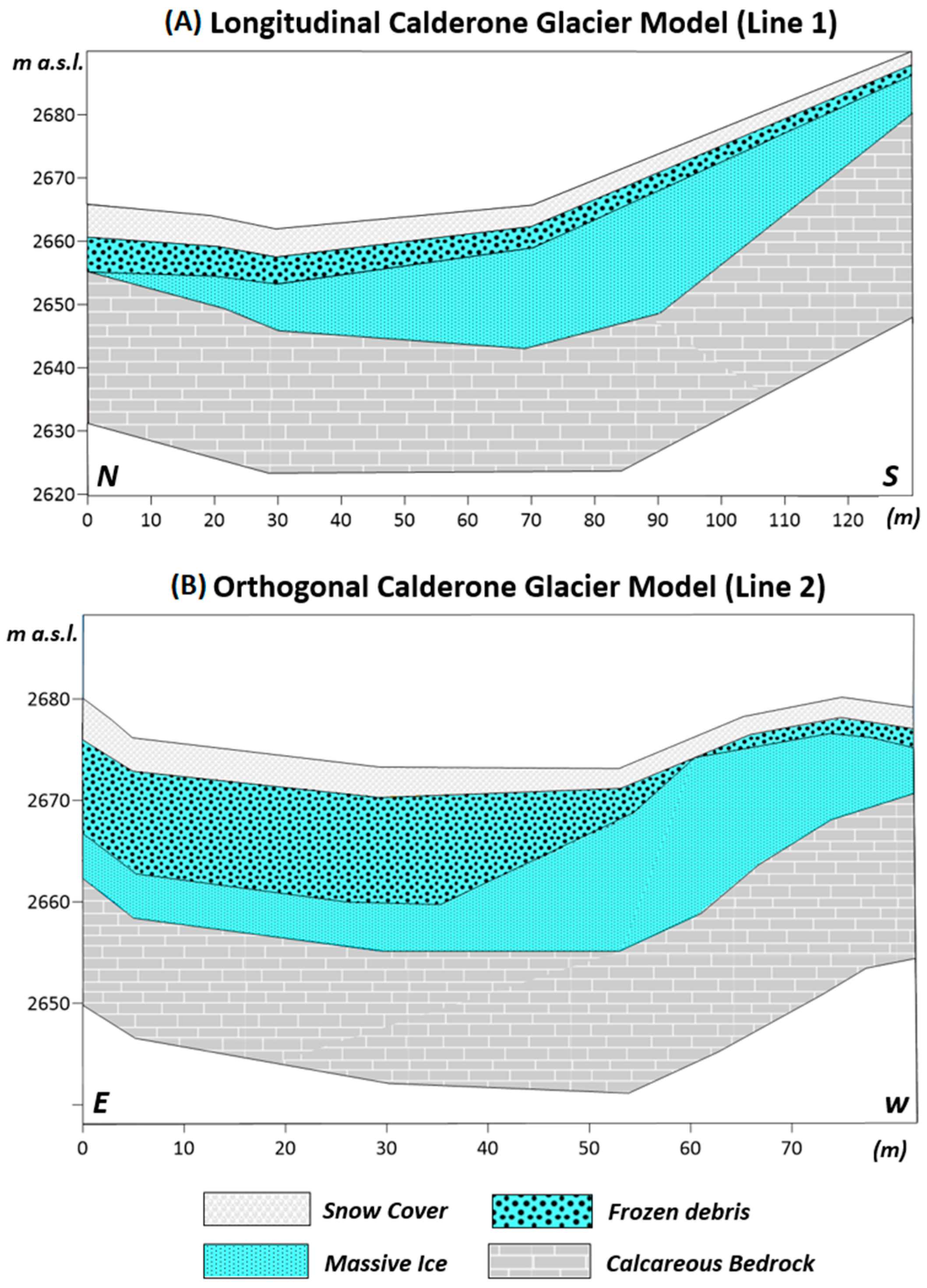
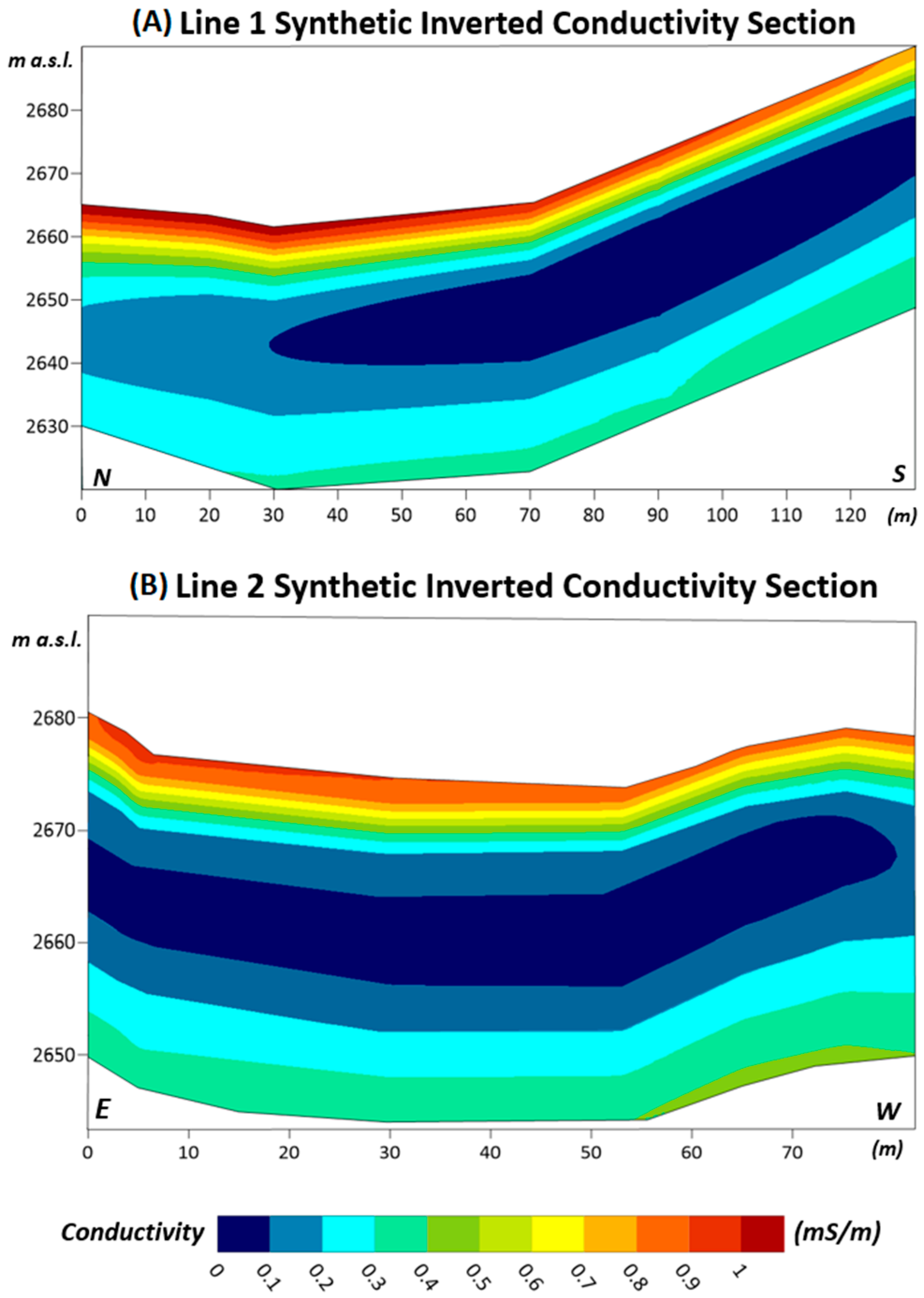


| Investigation Range (ns) | Samples (Points) | Simple for Second | Dynamic (Bit) |
|---|---|---|---|
| 400 | 1024 | 40 | 32 |
| Snow | Frozen Debris | Ice | Bedrock | |
|---|---|---|---|---|
| Conductivity (mS/m) | 1 | 2 × 10−2 | 1 × 10−3 | 2 × 10−1 |
Disclaimer/Publisher’s Note: The statements, opinions and data contained in all publications are solely those of the individual author(s) and contributor(s) and not of MDPI and/or the editor(s). MDPI and/or the editor(s) disclaim responsibility for any injury to people or property resulting from any ideas, methods, instructions or products referred to in the content. |
© 2023 by the authors. Licensee MDPI, Basel, Switzerland. This article is an open access article distributed under the terms and conditions of the Creative Commons Attribution (CC BY) license (https://creativecommons.org/licenses/by/4.0/).
Share and Cite
Pavoni, M.; Boaga, J.; Carrera, A.; Urbini, S.; de Blasi, F.; Gabrieli, J. Combining Ground Penetrating Radar and Frequency Domain Electromagnetic Surveys to Characterize the Structure of the Calderone Glacieret (Gran Sasso d’Italia, Italy). Remote Sens. 2023, 15, 2615. https://doi.org/10.3390/rs15102615
Pavoni M, Boaga J, Carrera A, Urbini S, de Blasi F, Gabrieli J. Combining Ground Penetrating Radar and Frequency Domain Electromagnetic Surveys to Characterize the Structure of the Calderone Glacieret (Gran Sasso d’Italia, Italy). Remote Sensing. 2023; 15(10):2615. https://doi.org/10.3390/rs15102615
Chicago/Turabian StylePavoni, Mirko, Jacopo Boaga, Alberto Carrera, Stefano Urbini, Fabrizio de Blasi, and Jacopo Gabrieli. 2023. "Combining Ground Penetrating Radar and Frequency Domain Electromagnetic Surveys to Characterize the Structure of the Calderone Glacieret (Gran Sasso d’Italia, Italy)" Remote Sensing 15, no. 10: 2615. https://doi.org/10.3390/rs15102615






